
|
 |
Enjoy the musical Tension. |
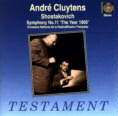 Shostakovich Symphony No. 11 in g, Op.103 "The Year 1905
Shostakovich Symphony No. 11 in g, Op.103 "The Year 1905André Cluytens (cond.)/National Radio Orch. of France Testament Building from near silence, the strings lightly creating the sound of wind blowing, Symphony No. 11 builds with an orchestral fury until finally, exhausted, it expires much like it began. It's Shostakovich's recreation of the Russian uprising of 1905. It was an ill fated insurrection that reached a momentary frenzy of bloodletting before fizzling into the history books with a whimper. The real Russian Revolution was some 12 years in the future yet Shostakovich also brings that tumultous period to bear on the music as well as the Hungarian invasion of 1956. The music, as presented by Cluytens and the National Radio Orch. of France accurately brings to mind the Czar's crushing reforms, the complete upheaval brought on by the communists and the tanks roaring through the streets of Budapest. They're able to convey, through the masterful use of violin, how chaotic aborted and successful revolutions can be. Recorded in 1958 in Paris, this is the first Western recording of the 11th, and shows how well Cluytens, despite not being Russian, was acclimated to presenting Shostakovich's profoundly personal compositions. The needed ingredient, intensity of feeling, is brought to the forefront in the careful balance of muted strings and trumpet. Perhaps not one of the most brilliant presentations of Shostakovich's 11th (that would be Mravinsky's 1967 recording), Cluytens effectively brought the proper feelings and atmosphere to the work. |
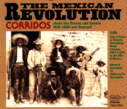 Various Artists
Various ArtistsThe Mexican Revolution Arhoolie Maybe it's because I find so many similarities between Mexican music and Polish music--the accordian and polka type rhythms--that I never seem to get enough of the various Mexican styles. We're talking corridos, tejano, and conjunto and what Arhoolie has given us with The Mexican Revolution is four jam-packed CDs spanning the breadth of the Twentieth Century and roaming across the vast expanse of the magical land that is Mexico. There are nearly 60 songs here, in the corrido style (epic lyrical narratives), that celebrate some of the most colorful characters in Mexico's near political past. A lot of the names of the sinister or the forthright figures these songs laud are pretty familiar; revolutionaries as varied in style as Francisco Madero, Porfirio Diaz, Pancho Villa, and Emiliano Zapata. And a great deal of the musicians are just as familiar: Lydia Mendoza, Hermanos Bañuelos, Los Hermanos Chavarría, There are some very obscure performances also, reaching as far back as a cylinder recording from 1904 by Rafael Herrera Robinson. Aside from the aforementioned 1904 recording, the songs are clear and of premium quality. The guitar sound is sharp, the accordians are extra crispy, and when the horns appear, as they do astoundingly on "Toma de Guadalajara" by Las Jilgüerillas y Los Hermanos Zermeño, the power they convey is remarkable. This is such a fun set of music that I contiuously find myself throwing it on and being swept away on the chords of revolution.
|
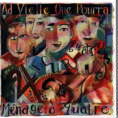 Ad Vielle Que Pourra
Ad Vielle Que PourraMénage à quatre xenophile With a dash of Irish melody and French roots music, Ad Vielle Que Pourra bring to light the closeness in musical styles of the two ethnic groups while exploring the distance between them. The whole foundation is jigs and reels and polka rhythms, but A.V.Q.P. is so much more than that. They're a French-Canadian band whose influences reach as far as the Greek isles and Acadia in the Southern United States. This may sound like too many disparate parts coming together to create a cohesive whole, but A.V.Q.P. astonishingly pull it off. These are four musicians with a firm grasp of the intricacies of each style, blending them for a cross-pollination that ends up being a wholely seperate style. Daniel Thonon is the real treat here as he jumps from hurdy-gurdy to accordion to piano to bagpipes to clarinet to darbouka to recorder to marimba to Jew's harp as his fellow A.V.Q.P. bandmates chip in with fiddle and guitar and kalimba. The most impressive track is "Ecoutez! Les Mamans (Hey! Listen Mommies)" with Pierre Imbert sounding like a French Leonard Cohen in a duet with Daniel Thonon's nine year old son Felix. The song is a dark, brooding meditation on fathers rights to see their children. Mostly lighthearted, Ménage à quatre is a spirited journey through French-Canadian life with the emphasis upon musicianship. |
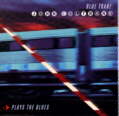 John Coltrane
John ColtraneBlue Trane: John Coltrane Plays the Blues Prestige Even though it's called Blue Trane: John Coltrane Plays the Blues this is the swingingest set of blues you're ever likely the hear. These recordings from 1957 and 1958 display a side of Coltrane rarely heard in his later years when he was expanding the boundaries of jazz. They're songs that harken back to his early days as a sideman in the Eddie "Cleanhead" Vinson and Earl Bostic bands, working as a blues or bebop player. His cast of supporting players, musicians such as Paul Chambers and Mal Waldron, who would continue to work with him until his death, show that they too know their way around a good blues tune. All the tracks have been previously released, yet combined here provide the listener with an opportunity to hear Coltrane plying his trademark tenor saxophone to a couple originals and some jazz standards in a setting most people won't be familiar with. Each track brims with the spark and inventiveness Coltrane inevitably brought to each session. The big plus of this collection is the inclusion of "The Real McCoy" from a Gene Ammons recording, with Coltrane stepping in on alto sax, his first instrument. This is one in a series of recent releases from Prestige that presents individuals lending their talents to the blues genre in jazz. The other titles are Blue Dex: Dexter Gordon Plays the Blues, Blues Wail: Coleman Hawkins Plays the Blues, Bluing: Miles Davis Plays the Blues, and Bluella: Ella Fitzgerald Sings the Blues. They're all fine examples of these artists working in an area that's not their normal territory. Check them out. |
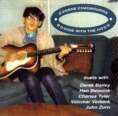 Eugene Chadbourne
Eugene ChadbourneBoogie with the Hook Leo Records I don't know what it is about this guy that continually draws me to him. It's either his disregard for structure, his sense of humor, his choice of material, or that wacked out voice of his, but he always seems to come up with something interesting and fascinating at the same time. Well, this time I have to say Eugene Chadbourne has come up short on all fronts. Boogie with the Hook is a lifeless mishmash of ill-chosen material and uninspired performances. Looking at the cover and seeing the names of the other musicians he's to duet with drew me into the exclusive Chadbournian world: Derek Bailey, Han Bennink, Charles Tyler, Volcmar Verkerk, John Zorn. It's a who's who of the avant-garde and a good enough roster for me to open the CD immediately and slap it on. Sure the trademark Chabourne string noodlings are there, but what's seems to be missing is any kind of direction for the music. Chadbourne and multi-instrumentalist Bennink start the album off with John Lee Hooker's "Whisky and Women," but before you know it they're off and running though a "Duet for Giant Bass Autoharp and Communist Banjo." It wanders aimlessly for over 8 minutes, the only highlight being Bennink's use of a pizza box as a percussion instrument. The track with guitarist Bailey is so short as to be non-existent. The only really interesting track is "In Between Comme C and Come Saw" with the late Charles Tyler on baritone sax and clarinet, recorded in 1977. Here Chadbourne has met his match in the world of wacko and for the next 13 minutes the world seems right. The last two tracks of the album, "The Banjo Duet" with Volcmar Verkerk and "Red Lightning, Part 1" with John Zorn sound as though Chadbourne went into the studio with each musician and simply said, "Let's just noodle around and see what we come up with." What they came up with in the words of my wife, "Isn't that Eugene Chadbourne? This is really annoying." At least she recognized his guitar playing. |
| Table of Contents |
| Tension | January 1997 |
 |